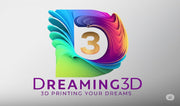The video game industry has always been at the forefront of technological innovation, pushing boundaries to deliver immersive and captivating experiences to players worldwide. In recent years, the integration of 3D printing technology has emerged as a game-changer, offering a new dimension to both the creation and consumption of gaming content. In this blog post, we'll explore the profound influence of 3D printing on the video game industry, from design and prototyping to personalized gaming peripherals and beyond.
- Prototyping and Game Development:
One of the primary areas where 3D printing has made a substantial impact is in the prototyping and development stages of video game creation. Game developers can now use 3D printing to rapidly prototype characters, props, and environments, allowing for quicker iteration and refinement. This not only accelerates the development process but also enables designers to physically interact with their creations, gaining valuable insights that can be challenging to achieve in a purely digital environment.
- Customization and Personalization:
As 3D printing becomes more accessible, gamers are reaping the benefits of personalized gaming experiences. From custom-designed characters to unique in-game items, 3D printing allows players to bring their virtual worlds into the physical realm. Companies are now offering services that allow gamers to order 3D-printed models of their in-game avatars or favorite game assets, creating a tangible connection between the virtual and real worlds.
- Gaming Peripherals and Accessories:
The gaming experience extends beyond the screen, and 3D printing has opened up new possibilities for creating customized peripherals and accessories. Gamers can now design and print their own controller grips, keyboard keycaps, or even entire custom controllers tailored to their preferences. This level of personalization not only enhances comfort and performance but also adds a unique touch to the gaming setup.
- Cosplay and Virtual Reality (VR):
The intersection of 3D printing and the video game industry is perhaps most evident in the realm of cosplay. 3D printing allows enthusiasts to recreate intricate and detailed costumes and props from their favorite games with unprecedented accuracy. This has led to a surge in the quality and authenticity of cosplay at gaming events and conventions.
Moreover, as virtual reality continues to gain traction, 3D printing plays a crucial role in the creation of VR accessories. From custom VR headset mounts to unique haptic feedback devices, 3D printing enables gamers to enhance their immersive experiences in the virtual world.
- Educational Opportunities:
The integration of 3D printing in the video game industry extends to educational initiatives as well. Schools and educational programs are leveraging 3D printing to teach students about game design, 3D modeling, and the iterative development process. This hands-on approach not only prepares the next generation of game developers but also fosters creativity and problem-solving skills.
Conclusion:
As 3D printing technology continues to evolve, its impact on the video game industry is set to grow even further. From the rapid prototyping of game assets to the creation of personalized gaming peripherals, 3D printing has become an integral part of the gaming ecosystem. The synergy between these two technological realms not only enhances the development process but also allows gamers to forge a more personal and tangible connection with their favorite virtual worlds. As we move forward, the marriage of 3D printing and the video game industry will likely bring forth even more innovative and exciting possibilities for both developers and players alike.
